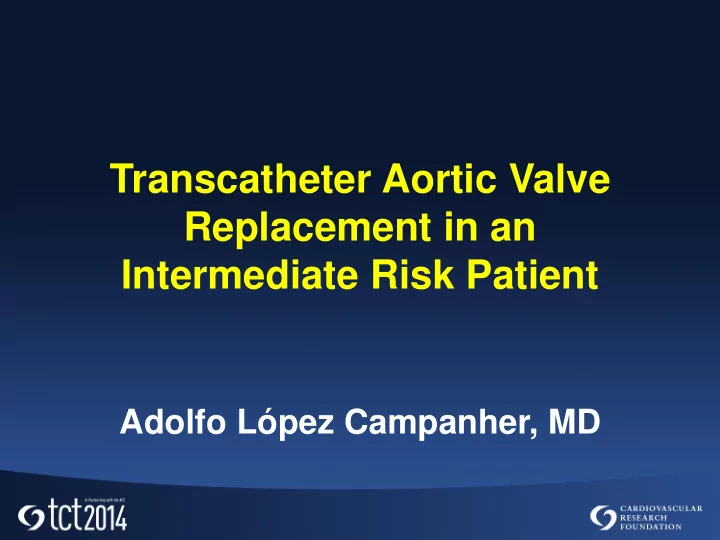

Transcatheter Aortic Valve Replacement in an Intermediate Risk Patient Adolfo López Campanher, MD
Disclosure Statement of Financial Interest I, Adolfo López Campanher DO NOT have a financial interest/arrangement or affiliation with one or more organizations that could be perceived as a real or apparent conflict of interest in the context of the subject of this presentation.
INTRODUCTION • Aortic valve stenosis is the most common form of valvular heart disease in the elderly population. • Approximately 30-40% of elderly patients with severe, symptomatic aortic valve stenosis are deemed ineligible for surgery because of high perioperative risk so transcatheter aortic valve replacement (TAVR) is indicated. JACC Cardiovasc Interv 2013;6(5):443-51
INTRODUCTION • Physicians are now selecting “lower” surgical risk patients to undergo TAVR. • It is unclear whether “off - label” TAVR treatment of patients considered intermediate-surgical-risk, (Society of Thoracic Surgeons scores: 3-8%), would effectively compete in safety and efficacy with surgical aortic valve replacement (SAVR). JACC Cardiovasc Interv 2013;6(5):443-51
CASE DESCRIPTION • 75 y.o. male. History of myelodysplastic syndrome, hypertension and congestive heart failure. Progressive shortness of breath at present time with minimal exertion. • Severely calcified aortic stenosis with an Aortic valve area by continuity ecuation of 0.4 cm2, mean pressure gradient of 61 mmHg and mild aortic reagurgitation. Left ventricular ejection fraction of 64%. • Surgery Risk Score: Intermediate with STS Score of 4. • Heart Team: TAVR and SAVR options were presented to the patient. Patient chose TAVR.
CASE DESCRIPTION Surgery Risk Score Isolated Procedure Name AVRepl Risk of Mortality 4.156% Morbidity or Mortality 23.776% Long Length of Stay 10.001% Short Length of Stay 25.572% Permanent Stroke 1.468% Prolonged Ventilation 16.686% DSW Infection 0.180% Renal Failure 6.988% Reoperation 9.510%
CASE DESCRIPTION Transesophageal echocardiogram was performed to measure the aortic annulus (1), valsalva sinus (2), sinotubular junction (3) and ascending aorta (4). 1 2 2.1cm 3.3 cm 2.5m 3.1cm 4 3
CASE DESCRIPTION A CT scans measurements A: Aortic Annulus: 18x25 mm B: Sinus of Valsalva: 33x33 mm C: Ascending aorta 32x30 mm B C
CASE DESCRIPTION Reconstructed multidetector computed tomographic images of the abdominal aorta and its pelvic branches and of the subclavian artery.
CASE DESCRIPTION Angiogram of the aorta and coronary angiography showing moderate stenotic lesion of the Left Circunflex artery.
CASE DESCRIPTION Annulus: 23 mm Sinus of Valsalva: 32 mm Sinotubular junction: 25 mm Ascending aorta: 34 mm Angiogram of the aorta and coronary angiography showing moderate stenotic lesion of the Left Circunflex artery.
CASE DESCRIPTION • The intervention was performed under general anesthesia and mechanical ventilation. • A temporary pacing lead was advanced in the right ventricle through the right femoral vein. • A 6F pigtail catheter was inserted for hemodynamic monitoring and landmark aortic angiography through the left femoral artery. • 6F sheath was then inserted into the right femoral artery. A 0.035 straight-tipped guidewire was placed in the LV using a left Amplatz (Boston Scientific) catheter. • Then a Cook 30-cm Check-Flo Performer 18F introducer (William Cook) was inserted over an Amplatz super stiff guidewire.
CASE DESCRIPTION • Native aortic valve was predilated with a Nucleus balloon 22-40 mm (NuMED) under rapid pacing.
CASE DESCRIPTION A Nº29 mm self-expandable CoreValve Revalving prosthesis (Medtronic Inc), was then introduced and implanted under angiographic and fluoroscopic guidance over the super-stiff wire, with immediate improvement of the hemodynamic status.
CASE DESCRIPTION • Immediately after CoreValve deployment, ascending aorta angiography was performed. • Vascular closure was performed using Prostar XL percutaneous vascular surgical system (Abbott Vascular).
CLINICAL EVOLUTION • The patient developed complete AV block so after 2 days permanent pacemaker was implanted. • Hospital discharge: 4 days after TAVR without any other complication. • After 10 days of discharge Transthoracic Echocardiogram was performed showing aortic valve area by continuity ecuation as 1.7 cm2, mean pressure gradient across aortic valve of 6 mmHg, mild aortic regurgitation and left ventricular ejection fraction of 66%.
CLINICAL EVOLUTION • After 3 months of discharge, Transthoracic Echocardiogram: aortic valve area by continuity ecuation as 1.5 cm2, mean pressure gradient across aortic valve of 10 mmHg, mild aortic regurgitation and left ventricular ejection fraction of 65%.
CO CONCL NCLUSIO USION • Patients with severe aortic stenosis considered at intermediate surgical risk are now being evaluated for TAVR. • Currently, there are no data about the clinical outcomes of TAVR compared with SAVR among such patients. • Randomized clinical trials comparing these 2 strategies in such patients are warranted. JACC Cardiovasc Interv 2013;6(5):443-51
Recommend
More recommend